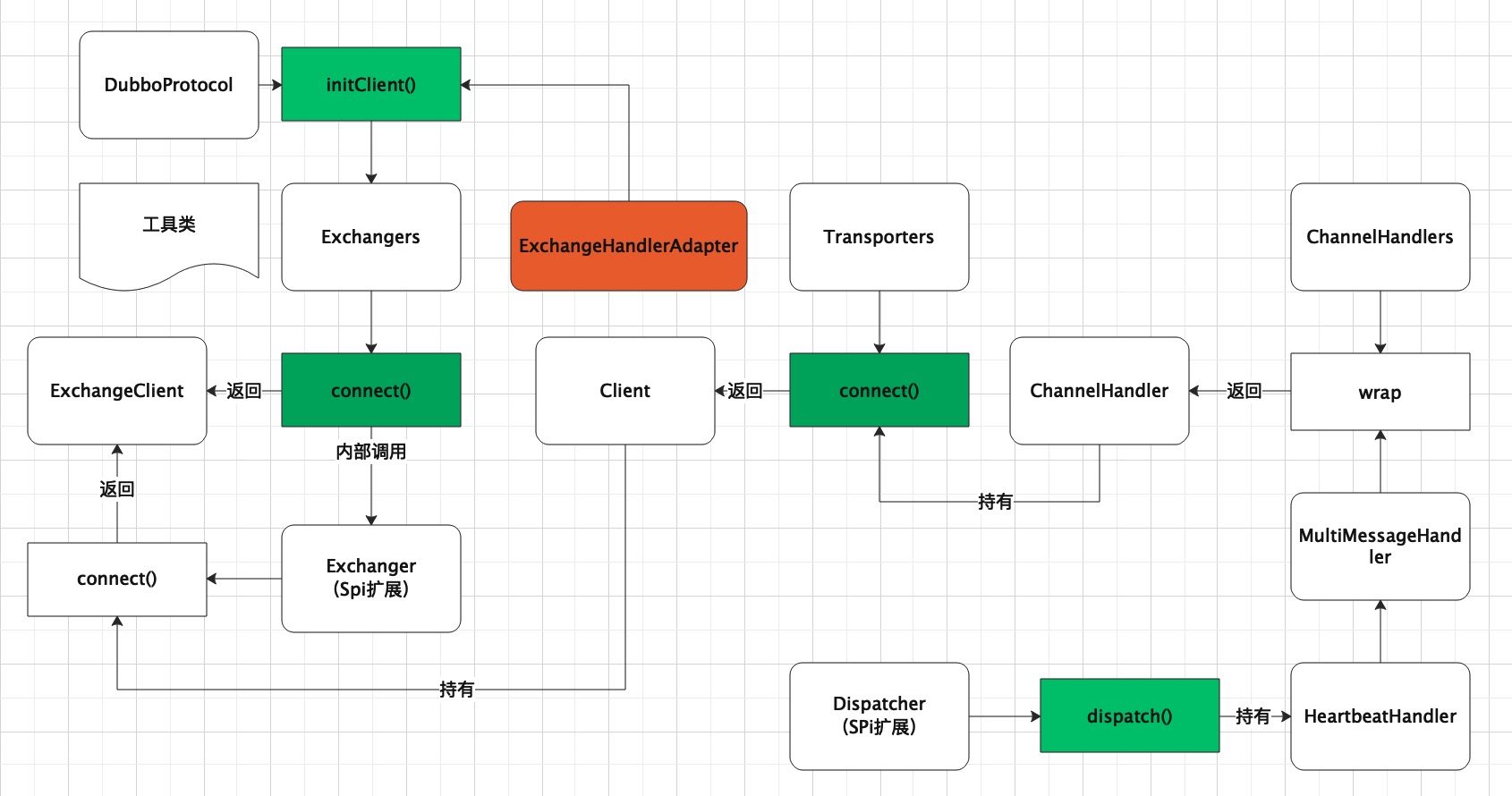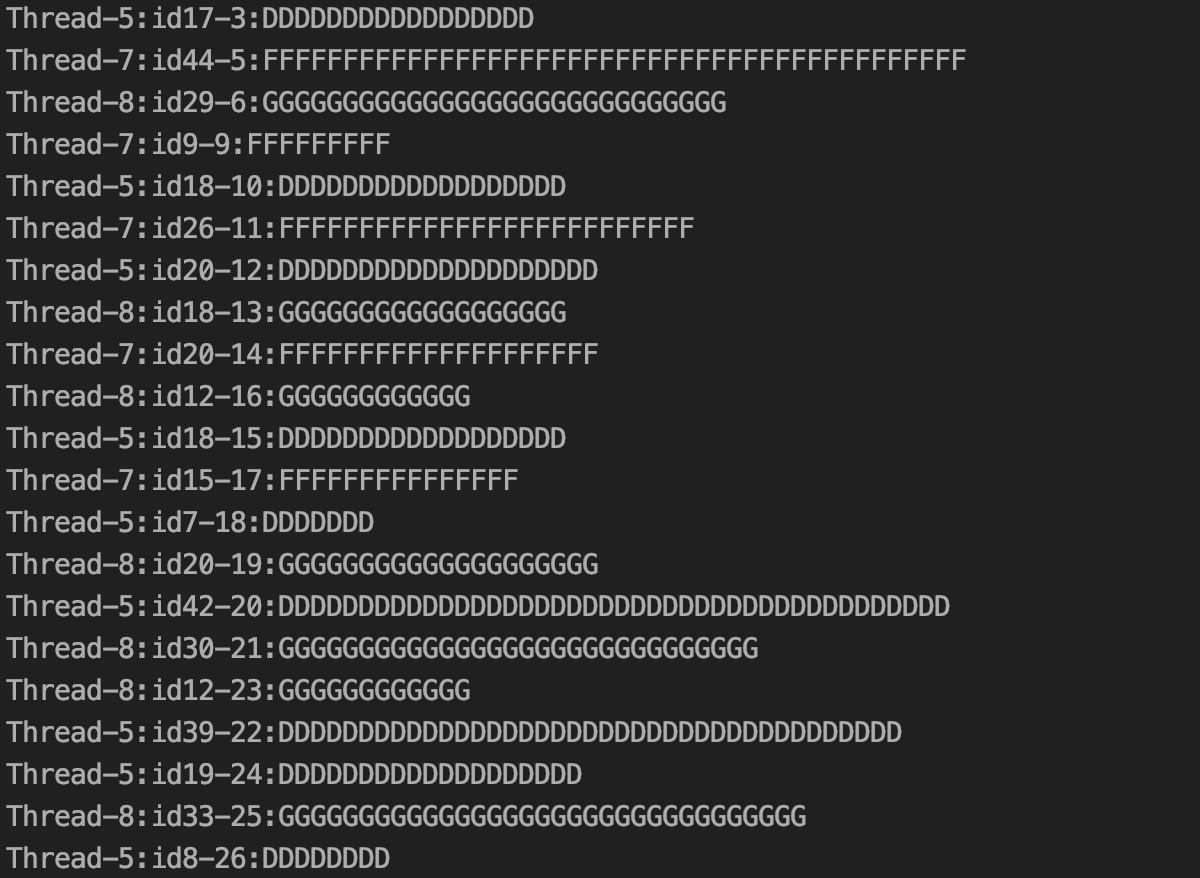Dubbo系列之 (七)网络层那些事(1)
辅助链接
Dubbo系列之 (一)SPI扩展
Dubbo系列之 (二)Registry注册中心-注册(1)
Dubbo系列之 (三)Registry注册中心-注册(2)
Dubbo系列之 (四)服务订阅(1)
Dubbo系列之 (五)服务订阅(2)
Dubbo系列之 (六)服务订阅(3)
Dubbo系列之 (七)链路层那些事(1)
在讲解dubboTCP端的设计时,先了解下一些类的关系图。它们是如何组织在一起的,每个功能又是什么,接着在进一步深入了解其内涵。
类简介
1、Exchangers(交换器工具类) 用来创建TCP服务(bind)和建立客户端连接(connect)辅助类
2、Transporters(数据流传输工具类)用来创建TCP服务(bind)和建立客户端连接(connect)辅助类,Exchangers的底层内容依赖于Transporters,并且Transporters会根据SPI扩展,来适配合适的tcp通讯框架,比如netty,mina等。
3、Exchanger(交换器) 用来创建TCP链接,通过工具类Exchangers完成,该接口是一个SPI扩展,目前唯一仅有就是HeaderExchanger。从名字的含义可以得到,该协议是具有自定义协议头的交换器,所以取名HeaderExchanger。
4、Transporter(数据传输层) 用来创建TCP连接,通过工具类Transporters完成。它也是一个SPI扩展,比如NettyTransporter,MinaTransporter。
5、ExchangeClient (交换器客户端),Exchanger的connect()方法返回,即建立了TCP连接后,返回的客户端,接着就是通过该客户端与服务端通信,实例有HeaderExchangeClient、LazyConnectExchangeClient、ReferenceCountExchangeClient。之后分别讲解这3个,Exchangers工具类建立的连接客户端是HeaderExchangeClient。
6、ExchangeServer (交换器服务端端) Exchanger的bind()方法返回,即服务端监听的服务端实例,它监听这某个具体的tcp端口。默认实现是HeaderExchangeServer。
7、RemotingServer(远程的TCP服务端),ExchangeServer类也实现了该接口,代表其也是一个远程服务器,具体的实现有NettyServer,由Transporter的bind()方法返回,具体的Transporter返回相应的远程服务端。比如NettyTransporter#bind()返回NettyServer。
8、Client(TCP客户端),ExchangeClient类也实现了该接口,代表其也是一个TCP客户端,具体实现有NettyClient,由Transporter的connect()方法返回,具体的Transporter返回相应的TCP客户端。比如NettyTransporter#connect()返回NettyClient。
9、Channel (通信通道) ,每建立一个TCP链接就相应创建一个Channel。比如Netty建立连接后,就有一个Channel。这里的Channel指的是dubbo自己定义的一个channel。它与netty的channel建立关联,通过NettyChannel类,框架操作的是NettyChannel,而NettyChannel内部持有一个netty的channel对象。
10、HeaderExchangeChannel(交换器Channel,ExchangeChannel属于交换器Channel),它被HeaderExchangeClient客户端所持有,客户端就是通过HeaderExchangeChannel进行通信的,HeaderExchangeChannel内部持有一个具体的Channel。
11、ChannelHandler (通道处理器) 用来处理建立连接、发送请求、结束请求等操作的具体抽象。
12、ChannelHandlers(通道处理器工具类) 主要用来包裹封装具体的Channel,它的作用是通过消息类型,根据Dispatcher返回不同的
13、Dispatcher(消息派发器)
| 类型 | Dispatcher | Channelhandler | 作用 |
|---|---|---|---|
| All | AllDispatcher | AllChannelHandler | 所有的消息类型全部通过业务线程池处理 |
| Connection | ConnectionOrderedDispatcher | ConnectionOrderedChannelHandler | 连接、断开消息单独通过一个线程池池来处理,其他的读写等消息通过业务线程池处理 |
| Direct | DirectDispatcher | DirectChannelHandler | 所有的消息都通过IO线程池处理,不放到业务线程池中 |
| Execution | ExecutionDispatcher | ExecutionChannelHandler | 请求消息在业务线程池处理,其他消息在IO线程池。 |
| Message | MessageOnlyDispatcher | MessageOnlyChannelHandler | 请求和响应消息在业务线程池处理,其他心跳,连接等消息在IO线程池处理 |
类关系图


试一把,Netty操作--客户端多线程,单链路(TCP)
1、定义传输消息
@Data
@ToString
public class SampleMessage {
private String threadName;
private String id;
private String desc;
}
2、编写编码器
public class SampleEncoder extends MessageToByteEncoder<SampleMessage> {
protected void encode(ChannelHandlerContext channelHandlerContext, SampleMessage sampleMessage, ByteBuf byteBuf) throws Exception {
String threadName = sampleMessage.getThreadName();
String id = sampleMessage.getId();
String desc = sampleMessage.getDesc();
byteBuf.writeInt(threadName.getBytes().length);
byteBuf.writeBytes(threadName.getBytes());
byteBuf.writeInt(id.getBytes().length);
byteBuf.writeBytes(id.getBytes());
byteBuf.writeInt(desc.getBytes().length);
byteBuf.writeBytes(desc.getBytes());
String str = sampleMessage.getThreadName() + ":" + sampleMessage.getDesc() + ":" + sampleMessage.getId();
System.out.println(str);
}
}
3、编写解码器
public class SampleDecoder extends ByteToMessageDecoder {
protected void decode(ChannelHandlerContext channelHandlerContext, ByteBuf byteBuf, List<Object> list) throws Exception {
byteBuf.markReaderIndex();
String threadName = read(byteBuf);
if (threadName == null) {
byteBuf.resetReaderIndex();
return;
}
String id = read(byteBuf);
if (id == null) {
byteBuf.resetReaderIndex();
return;
}
String desc = read(byteBuf);
if (desc == null) {
byteBuf.resetReaderIndex();
return;
}
SampleMessage sampleMessage = new SampleMessage();
sampleMessage.setId(id);
sampleMessage.setThreadName(threadName);
sampleMessage.setDesc(desc);
list.add(sampleMessage);
}
private String read(ByteBuf byteBuf) {
if (canReadInt(byteBuf)) {
int readInt = byteBuf.readInt();
if (canReadN(byteBuf, readInt)) {
byte[] bytes = new byte[readInt];
byteBuf.readBytes(bytes);
return new String(bytes);
}
}
return null;
}
private boolean canReadInt(ByteBuf byteBuf) {
return canReadN(byteBuf, 4);
}
private boolean canReadN(ByteBuf byteBuf, int n) {
if (!byteBuf.isReadable()) {
return false;
}
return byteBuf.readableBytes() >= n;
}
}
4、编写消息处理器
public class PrintChannelHandlers extends ChannelInboundHandlerAdapter {
@Override
public void channelRead(ChannelHandlerContext ctx, Object msg) {
if (msg instanceof SampleMessage) {
SampleMessage sampleMessage = (SampleMessage) msg;
System.out.println(sampleMessage.getThreadName() + ":" + sampleMessage.getId() + ":" + sampleMessage.getDesc());
}
}
}
5、编写服务端
public class NettyServerMain {
public static void main(String[] args) {
ServerBootstrap serverBootstrap = new ServerBootstrap();
serverBootstrap.group(new NioEventLoopGroup(1), new NioEventLoopGroup(12))
.channel(NioServerSocketChannel.class)
.childOption(ChannelOption.TCP_NODELAY, Boolean.TRUE)
.childOption(ChannelOption.ALLOCATOR, PooledByteBufAllocator.DEFAULT)
.childHandler(new ChannelInitializer<SocketChannel>() {
@Override
protected void initChannel(SocketChannel ch) throws Exception {
ch.pipeline()
// .addLast("log",new LoggingHandler(LogLevel.INFO))
.addLast("decoder", new SampleDecoder())
.addLast("encoder", new SampleEncoder())
.addLast("handler", new PrintChannelHandlers());
}
});
ChannelFuture channelFuture = serverBootstrap.bind(8888);
channelFuture.syncUninterruptibly();
System.out.println("链接前");
Channel channel = channelFuture.channel();
System.out.println("链接后");
}
}
6、编写客户端
public class NettyClientMain {
public static void main(String[] args) {
NettyClientMain nettyClientMain = new NettyClientMain();
nettyClientMain.open();
}
public void open() {
Bootstrap bootstrap = new Bootstrap();
bootstrap = new Bootstrap();
bootstrap.group(new NioEventLoopGroup(10))
.option(ChannelOption.SO_KEEPALIVE, true)
.option(ChannelOption.TCP_NODELAY, true)
.option(ChannelOption.ALLOCATOR, PooledByteBufAllocator.DEFAULT)
.channel(NioSocketChannel.class);
bootstrap.option(ChannelOption.CONNECT_TIMEOUT_MILLIS, 3000);
bootstrap.handler(new ChannelInitializer<SocketChannel>() {
@Override
protected void initChannel(SocketChannel ch) throws Exception {
ch.pipeline()//.addLast("logging",new LoggingHandler(LogLevel.INFO))//for debug
.addLast("decoder", new SampleDecoder())
.addLast("encoder", new SampleEncoder());
//.addLast("handler", new PrintChannelHandlers());
}
});
SocketAddress socketAddress = new InetSocketAddress("127.0.0.1", 8888);
ChannelFuture future = bootstrap.connect(socketAddress);
boolean ret = future.awaitUninterruptibly(3000, MILLISECONDS);
if (ret && future.isSuccess()) {
Channel newChannel = future.channel();
doProcess(newChannel);
}
}
private void doProcess(Channel channel) {
AtomicLong atomicLong = new AtomicLong();
for (int i = 0; i < 15; i++) {
final char ch = (char) (i + 65);
final String id = "id" + i;
Thread t = new Thread(new Runnable() {
@Override
public void run() {
while (true) {
SampleMessage sampleMessage = new SampleMessage();
sampleMessage.setThreadName(Thread.currentThread().getName());
sampleMessage.setDesc(getdes(ch));
sampleMessage.setId("id" + sampleMessage.getDesc().length() + "-" + atomicLong.getAndIncrement());
channel.writeAndFlush(sampleMessage);
}
}
});
t.start();
}
}
private String getdes(char a) {
Random random = new Random();
StringBuffer buffer = new StringBuffer();
for (int i = 0; i < random.nextInt(500) + 1; i++) {
buffer.append(a);
}
return buffer.toString();
}
}
7、测试结果

结果符合预期,dubbo 也是通过服务底层公用一条TCP链接,多线程进行调用该链路channel。


